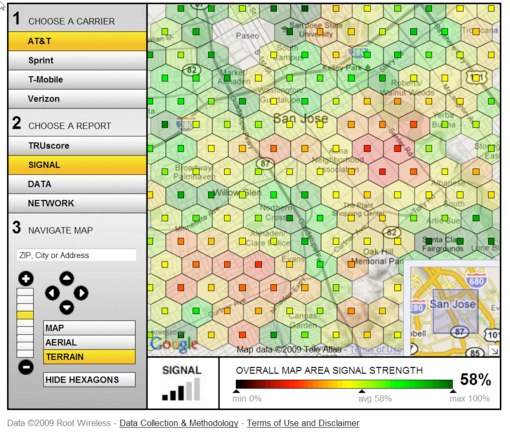Two bars at home; three at work. Wireless coverage data is going granular

Say goodbye to those no-help coverage maps that the wireless carriers use to show you how great their coverage is from one coast to the other. So hello to granular maps, those that measure the true signal as well as the actual data coverage down to the Google Maps street level.

Root Wireless data gives a glimpse of A&T coverage near downtown San Jose. Notice that red represents poor coverage. A dead zone would be black.
On the surface, this type of data finally empowers the consumer to judge the carriers based on close-up data about the service but it does more than that. It holds the carriers accountable for the promises they make about coverage.
A CNET poll found that 26 percent of the respondents had returned a cell phone due to poor service while 45 percent said there wasn't enough information available about service quality when making a cell phone purchase decision. Nearly half are considering switching service providers with the next cell phone purchase.
But what about the areas that are outside of the big cities? What if you live in work in a suburb of Atlanta or Boise or Des Moines? Well, there will soon be an app for that - and by downloading and installing it on your device, you could become part of the solution to the problem.
In the next month or so, Root Wireless will launch a beta program that allows owners of Blackberry, Android and Windows Mobile devices (iPhone in the works) to run a background app that reports actual signal strength from the device into a greater Root Wireless database. (If you want to be a part of this beta program, it's as easy as sending an email to info@rootwireless.com)
Eventually, that program will be extended to other devices, a critical piece of information because that further extends the database to give readings by not only carrier but also device. Widespread rollout of the app program is expected late this year or early next year.
So, yes, eventually you'll be able to determine whether the iPhone on AT&T or Verizon or an Android device on Sprint or T-Mobile offers the better service for your locations. In fact, the data can be sliced and diced so many different ways that the execs at Root Wireless say there's a lot of stuff in the works. The one I like is where you pinpoint some spots on a map - maybe your commute route, home, work, your favorite hangouts and maybe even Grandma's house in another town. Based on that information, the data would be able to "score" the carriers for you to let you know which is best.
Finally, this is technology that's going to change the way we purchase - and complain about - cell phone service. Maybe, with this information, consumers will do what I've been suggesting for years now: shop the service, not the phone.